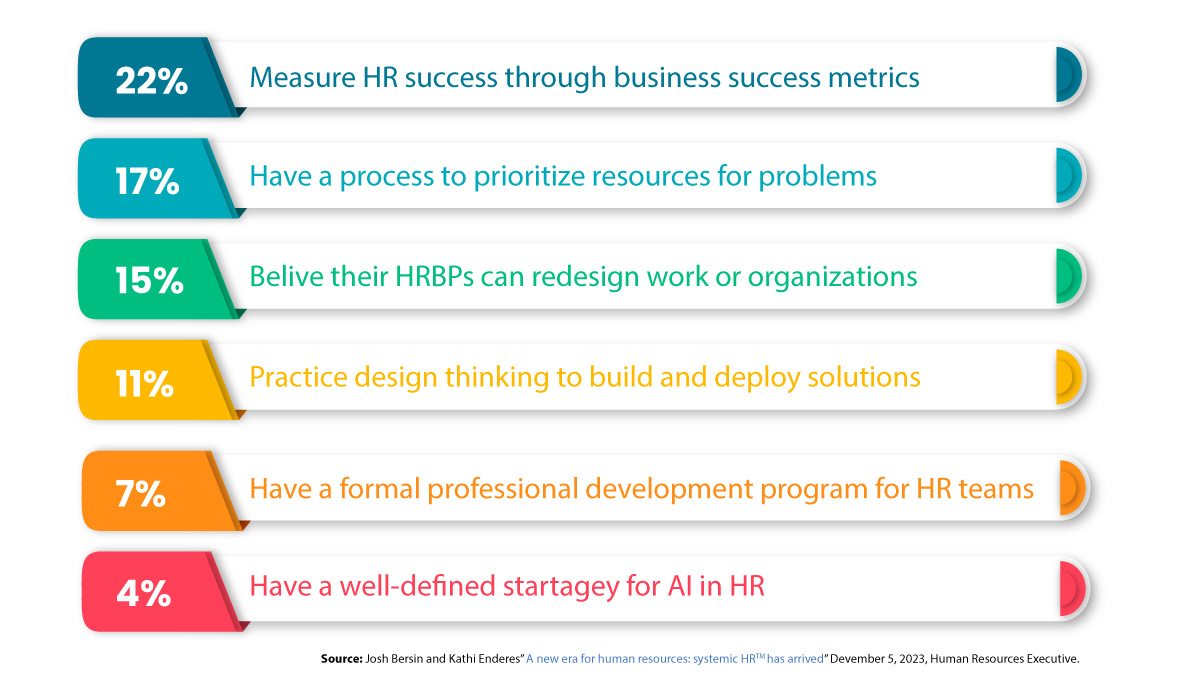
When I read Josh Bersin's "Beyond HR Transformation: Systemic HR – Four Stages Of Growth" last October, I sat up straight and thought to myself, "It's here at last!"
I've considered HR a fragmented function since my grad school days at HPU.
During my years in HR software implementation consulting, I frequently suggested aligning HR and business strategies. The most common response was something like, "We don't have time for that right now."
But Bersin's productization of the concept promises to break down the barriers with advocacy. This is backed up by training at the Josh Bersin Academy, which offers courses aimed at developing HR Business Partners as practitioners with the skills to lead business talent strategy.
Bersin's research shows that most HR teams aren't ready. The evidence is in the responses to the company's survey on alignment.

Transforming HR for Business Success
The idea of transformation from segmented HR centers to cohesive teams grew out of Bersin's work in Irresistible: the Seven Secrets of the World's Most Enduring, Employee-Focused Organizations. It has arrived as a natural consequence as HR develops in stages, from basic functions to service delivery, then to product offerings, and now begins transitioning into a consulting role. Systemic HRTM isn't just a gaggle of functions within a company; it's a strategy that drives an adaptable business that can pivot to threats and opportunities.
Business-Aligned HR Strategy
A fundamental shift to a business-aligned HR strategy requires us to ensure that we craft every HR policy and initiative with the business goals in mind. This alignment is the foundation for Systemic HR.
Integrated HR Operating Model
By adopting an integrated HR operating model, organizations promote a comprehensive approach where HR works harmoniously with all departments, nurturing a sense of unity and shared objectives.
Systemic People Analytics
Data forms the backbone of Systemic HR. By interweaving people analytics data with HR and business information, we are empowered to make decisions that sustain the strategy for the long haul.
Purpose-Built HR Technologies
Modern HR equips people and their managers with purpose-built technologies designed to streamline operations and instill an ethos of continuous improvement.
HR Audit
An honest, thorough HR audit sets the stage by pinpointing current functional strengths and growth opportunities.
Adequate Resources
From ensuring the HR team is correctly staffed to equipping them with cutting-edge tools, a successful implementation involves investing wholeheartedly in the human element.
Open Communication
Finally, nurturing a culture of openness bridges the gap between HR and other departments, ensuring a synergy that propels the entire organization towards common goals.
This approach will enable your HR team to integrate people data, HR data, and business data together. It will help your organization become agile and adaptable, capable of mobilizing skills and technologies to operate in a volatile business environment.
Preparing to Implement Systemic HR
The future will belong to those organizations that can quickly overcome business and talent challenges. A well-aligned, cohesive organization is your first step in building a culture that will adapt to whatever the future will bring.
1. Secure and Maintain Executive Support
Help your executive team embrace the change. Show them how Systemic HR is a lever for business success and clarify that their sponsorship will align your entire organization.
Use people data to inform business strategy, and business strategy to inform individual and team development.
2. Turn Managers and HR Business Partners into Advocates
Make managers part of the transformation. Equip them with insights and the benefits of Systemic HR so that they can lead by example. The fastest path will be enrollment in the Josh Bersin Academy.
3. Design with Engagement at Every Level
The best way to engage employees in a new organizational design is to involve them in the design from the start. Solicit their input, address their needs, and ensure the changes resonate with them. After all, Systemic HR is, at its heart, about fostering an enriching environment for every individual in the organization.
4. Measure Success
Success in implementing a systemic approach to HR can be seen both in the vibrancy of the organizational culture and the hard numbers. Look for increased employee satisfaction and retention rates, a rise in productivity, and, importantly, the achievement of financial targets.
Use key performance indicators (KPIs) to monitor progress and adapt as necessary. Remember, Systemic HR is about being as responsive and adaptive as the market conditions and internal culture dictate.
Conclusion
In the end, Systemic HR is more than a department or a set of operations—it's a mindset aimed at enabling your organization to pivot and execute on emerging conditions and opportunities. By taking these steps, your business will not merely adapt; it will thrive by setting a new standard for what HR can be and achieving excellence across every measure.
About Pixentia
Pixentia is a full-service technology company dedicated to helping clients solve business problems, improve the capability of their people, and achieve better results.

